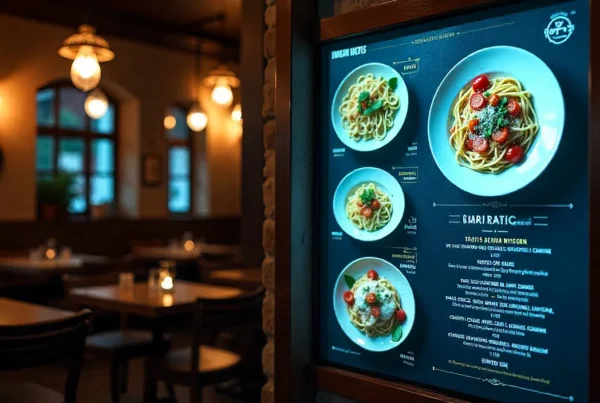Today’s super-connected world thrusts an expectation of getting instant access to information from customers. It can be real-time promotions updates, live weather alerts or social media feeds; businesses must have their audience on the edge. Real time information digital signages are used for this purpose.
The service further extends the dynamic technology into a device more than a display screen for businesses to provide up-to-the-minute information, automated updates for content, and interactive experiences. Real time information digital signage is changing communication practices in the retail and hospitality, healthcare as well as in the corporate sector.

What is Real-Time Information Digital Signage?
Real time information digital signage is a display of live content that automatically updates by using the data feeds, AI driven automation and the API integrations. Real time signage differs from the static and obsolete conventional signage, in that it provides instant updates which keep the information relevant, alive, interactive.
Key Uses of Real-Time Digital Signage:
• Retail & Advertising: Flash sales, promotions, livestock availability.
• Corporate Communication: Employee updates, meeting schedules, and KPI dashboards.
• Transportation & Public Spaces: Live traffic, weather reports, and emergency alerts would fall under this category.
• Healthcare & Medical Facilities: Updates on waiting time, appointment schedule, and emergency messages.
With real-time data sources such as RSS feeds, social media, or IoT sensors, businesses can automate and customize the content in a way to have a fluid customer experience.
How It Works
The main (core) functionality of the real-time information digital signage technology is the ability to display things at the level of dynamic automated updates from the live data feeds.
Step-by-Step Breakdown of How It Works:
1. Data Integration: Live information is pulled from various sources including:
o Weather APIs (e.g., Open Weather for real-time forecasts).
o Stock Market Feeds (e.g., Yahoo Finance API for financial updates).
o Social Media Integration (e.g., Twitter/X live feeds, Instagram engagement).
o POS Data (e.g., automatically pricing according to inventory levels).
2. Content Management System (CMS): The raw and, usually, real-time information is formatted by digital signage software into engaging content in a Content Management System (CMS) and displays automatically update without manual intervention.
3. Display & Interactivity: The Content is displayed on LED screens, Kiosks, and Interactive Touch Screens, and customers can interact with the dynamic content.
API-based integrations allow businesses to automate content updates and keep it real-time accurate.
Benefits for Businesses
Real time digital signage implementation provides a tangible business benefit for businesses.

Key Advantages:
Dynamic & Eye-Catching Visuals: Eye-catching visuals have a better hold on to customer attraction 5 times more than static signage.
Cost savings: Businesses can save on the recurring costs of printing promotions as well as make remote updates to promotions across multiple locations.
Automate More Sales & Upsell: AI-powered digital signage promotes the highest margin products according to customers’ behavior and demand.
Improved Employee Communication: Internal displays facilitate corporate messaging, team updates, employee training, etc.
Eco-Friendly & Sustainable: Avoids paper waste by doing away with the need to print posters and print posters.
Retail Case Study: A major retailer who used real-time digital signage saw it increase in sales of 30% of promoted items through the use of AI-based content adaptation.
Solutions & Technologies
There are several technologies and solutions to implement real time information digital signage. Depending on their needs, businesses can choose either cloud based or on-premise systems.
Cloud-Based Real-Time Digital Signage
Real time information digital signage systems based on cloud offer many more advantages such as remote management, scalability and lower upfront cost. The cloud also allows businesses to push changes to displays located in different locations from a common central system. It is suitable for companies with many branches or global operations.
On-Premise Real-Time Digital Signage
On-premise real-time signage is a good solution for businesses that need a greater amount of control over their systems and prefer not to trust a third party. This kind of system works well in companies with particular privacy requirements and typically needs a dedicated network and hardware to support it.
Interactive & AI-Powered Digital Signage
Another bonus is interactive and also AI-powered digital signage. Ordinary touchscreens, facial recognition, and AI-driven content recommendations render adaptive experiences with the customers taking more interest. In particular, this is highly valuable in retail environments where offering personalized content and offers are proven to increase sales.
IoT & Sensor-Integrated Digital Signage
With the expanded presence of the Internet of Things (IoT), the more apparent it has become to see sensor-integrated real-time signage appear. The content on the display can be adjusted to the customer’s behavior, temperature changes, or even crowd size through sensors. For instance, special promotions might be shown on a display if a high number of customers approach it.
Hardware & Equipment
The hardware components involved in building a working real-time information digital signage system are as follows:
• Digital Displays & Screens: From simple monitors to large high-resolution displays that generally draw attention, this often ends up being the most hectic and last-minute type of project, sent out late, being relatively inexpensive, and likely bulletin board material.

• Media Players & Controllers: Control and play the content on digital displays. It can be on-site hardware or cloud cloud-based system.
• Touchscreen Kiosks: Help customers browse through information, browse products, or transact without assistance from another person keep customers engaged with your brand.
• Connectivity and Network Solutions: The network connection needs to be very strong in order to allow smooth transmission of content updates and data feeds.
Software & Integration
Real time digital signage to work smoothly needs to have strong software as well as integration capabilities.
• Content Management Systems (CMS): A powerful CMS to manage the content that will be accommodated on the digital displays. Included in this are images, live data feeds, and scheduling content.
• Real-Time Data Feeds and API Integration: Live data feeds from multiple sources can be integrated to enable the signage to display information related to the most updated information possible.
• Scheduling & Automation Tools: These tools help businesses schedule content updates at the right time so that the display content is new.
• Security & Compliance: Strong security measures are needed to secure the hardware and software used in real-time digital signage. Since your signage should be usable by all people, including those with disabilities, compliance with accessibility standards is a must.
Applications & Industries
There are several industries that use real time information digital signage. Some common applications include:
• Retail & Advertising: Displaying content like promotions, special offers, etc., based on real-time data or customer behavior can be done using a similar dynamic model.
• Corporate Offices & Workspaces: Real-time signage can become meeting schedules, news updates, or employee announcements in corporate offices & workspaces to facilitate in-house communications.

• Transportation Hubs & Public Spaces: Airports, bus stations, and train stations sometimes use real-time signage to give travelers running late up-to-date schedules, the weather, and news.
• Healthcare & Medical Facilities: Real-time Installed signs in the healthcare environments could show waiting times, appointment status, etc, or emergency alerts.
• Hospitality & Entertainment Venues: Hotels and such entertainment venues may use real-time signage to provide guest information, event schedules, or even local recommendations.
• Educational Institutions & Campuses: Campuses can show live schedules, class changes or event updates, and so on, for better communication in the school.
Content Strategies
In order to be as effective as possible, businesses should be automating the content with AI.
• AI Driven Personalization: Promotions should be personalised to the customer’s demographic with no delay.
• Live Social Media Feeds: Real-time Customer Reviews, Hashtags, and Brand interactions from Live Social Media Feeds in this app.
• QR Code Engagement: Get customers to scan and engage for discounts, to access the menu, or to get exclusive deals.
For example, Walmart uses AI-driven signage to adjust pricing according to the demand in order to raise the sell-through rates by 20%.
Case Studies & Success Stories
There are several successful instances of businesses that have implemented real-time information digital signage technology and transformed it into a big success.
McDonald’s Digital Menu Transformation:
In selected restaurants, by changing to AI real-time Digital menu boards for dynamically tuning the promotions based on peak hours, the sales increased by 3-5%
Healthcare Digital Signage Impact:
Real-time signage from hospitals that reduced real-time wait time-related complaints by 40% enabled patients to see live queue updates.
Retail Digital Engagement Boost:
Interactive digital signage can boost the dwell time of the customers by 30 to 50%, which helps to make additional impulse purchases.
Comparison Table: Real-Time Digital Signage vs. Static Signage
| Real-Time Digital Signage | Static Signage |
| It can display live, up-to-date information, such as news or weather. | Content remains fixed, requiring manual updates. |
| Offers dynamic content that engages customers in real time. | Content can become outdated, limiting engagement. |
| Enables integration with APIs for live data and social media feeds. | Does not have the ability to integrate real-time data. |
| Perfect for advertising, public spaces, corporate communication, and more. | Best for simple advertisements or fixed announcements. |
Future Trends & Innovations
As the future of real time signage, there are some trends making this future exciting.
• AI & Machine Learning in Digital Signage: As AI continues to evolve, digital signage will become smarter, offering more personalized and relevant content to users.
• Sustainability & Energy Efficient: The future digital signage will incorporate energy saving and sustainability, which entails using eco-friendly materials and low-energy displays.
• Emerging Technologies & Future Predictions: New technologies, such as 5G and Augmented Reality, that are coming up can further increase interactivity and depth of information on digital signage on a real-time basis.
Why Your Business Needs Real-Time Digital Signage
Real-time digital signage is exactly on trend; it’s how business messages will be communicated in the future. If you’re a retail store, corporate office, or restaurant, dynamic digital signages are handy for enhancing outreach and automation and achieving more sales.
👋 Are you ready to transform your business with real-time digital signage?
Explore Nento’s cutting-edge digital signage solutions today and take your marketing strategy to the next level!
FAQs
What is real-time digital signage?
Real-time digital signage indicates what is displayed that shows live content like news updates, social media feeds, and weather forecasts by real-time data.
How can real-time digital signage benefit my business?
It can enhance communication, enhance customer engagement, and decrease the costs linked to customary signage.
What types of businesses use real-time digital signage?
Real-time digital signage is used by businesses in healthcare, corporate offices, and public spaces.
How do I integrate real-time data into my digital signage?
It accepts real-time data via APIs, content management systems, or automation tools.
Is real-time digital signage secure?
Yes, but it is paramount to ensure that the hardware and software are secure enough.





